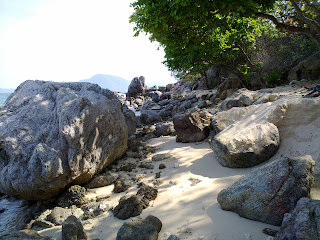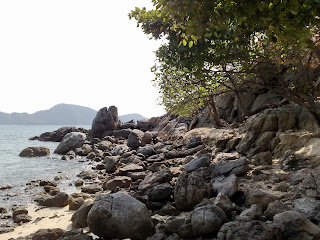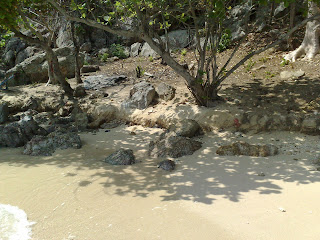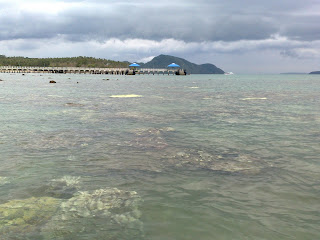Tropical Storm Mindulle

Three reporters from the Thai TV channel 3 almost lost their lives when their car was washed away. They managed to climb out at the last minute when the car got stuck against some banana trees. Local villagers came to their rescue and all was well in the end.
In the meantime at Bon Island, Phuket we were having much more fun! Exciting weather is a always worth a photo or too!

In Memory of Tropical Storm Harriet 25th October 1962 at Laem Talumphuk - แหลมตะลุมพุก 25 ตุลาคม 2505
As the rainy season is here it's time to be thinking about the weather and especially the danger that tropical storms present. Luckily in Phuket this year the rainy season, so far, has not brought any major storms, although we have had some strong winds and heavy rain.
On this note that I want to mention the Tropical Storm Harriet that took the lives of over 1000 people and leaving over 16,000 homeless in the village at Laem Talumphuk. I was one year old and safe in England at the time, but I can imagine the extent of the disaster as it was probably of a similar level to that of the 2004 tsunami here in Phuket. Back in 1962 disaster relief was not as efficient as it is now, and certainly disaster preparation was virtually unheard of. So it was today that I watched the Thai film ตะลุมพุก (Talumphuk) that in turn made me curious to find out a bit more, and lead me to the Laem Talumphuk facebook page (in Thai) which has some links and photos for anyone who is interested:
and also on Wikipedia:
and also at:
However it is worth putting thing into perspective by taking a look at Weather
Underground's list of the 30 Deadliest Tropical Cyclones in History. Clearly Bangladesh has been hit the hardest. It is also worth noting that Cyclone Nargis in 2008 currently ranks 9th.
Hopefully we won't have to experience anything like this again.
What's happened to the beach?

December 6th 2009

And so now I return with another photograph of the same stretch of beach, this time taken on 3rd December 2009 one month on from the photo at the top of this blog which was taken on November 4th 2009. The beach has receded a lot, exposing more rocks and it has still to go further back. I will return again soon with the next update!

After the strong wind yesterday, strong waves cut away at the sand even more, leaving many more rocks exposed and carving a shelf along the beach.




Now it's already half way through January 2010 and the beach has changed a lot, there will be no tourists lying on this corner of the beach until the sand starts to move back again in about three months time.

And so as it nears the end of Phuket's 'High Season' and the beginning of the monsoon season, the beach has been through the first half of the annual cycle. The sand has moved from east to west and, as the photo taken on April 2nd 2010 shows, all that remains are rocks.


May brings a late start to the monsoon season this year, but within just a few days it seems are beach is moving back to the east again as you can see from these photos taken on the 29th May 2010!



Is this the rainy season.....

I guess I should have realised that the extreme heat yesterday, accompanied by some threatening clouds, was a warning that Phuket's rainy season was about to start. It did at around 4am today!
A few more days have passed with intermittent rain showers and as we arrive at the beginning of June it seems that the month of May has had a much lower rainfall than average. Phuket still has a water shortage problem despite the fact that the rainy season has officially begun.
Rain, rain come again!
a
The weather in Phuket seems to have cooled down a little bit today after a series of thunderstorms and heavy rain last night. This means that maybe there is some hope for the coral that has already suffered from bleaching due to high water temperatures.



The weather in Phuket seems to have cooled down a little bit today after a series of thunderstorms and heavy rain last night. This means that maybe there is some hope for the coral that has already suffered from bleaching due to high water temperatures.

Coral bleaching at Rawai Beach.
On a walk over the rocks to explore just how wide spread the coral bleaching has become, I found that pools of what was probably rain water (the sea wouldn't reach this point) had evaporated leaving a hard sediment of salt. Although this is normal, I have rarely seen such a thick layer of salt filling the indent in the rocks before, usually it's more like a thin coating. The immediate evaporation of fresh water just adds to the problems for animals and plants in their struggle to survive until the rainy season.

Heat Wave.

Thailand is facing the hottest weather in 20 years.
Health warnings have been issued by the Health Department. With several deaths from heatstroke being reported around Thailand.
Due to the increase in sea temperature, the are widespread occurrences of Coral Bleaching in the Andaman Sea, and if the temperature doesn't drop soon, the coral may die.
Water Shortage.

Due to the lack of rain over the last few months there is no fresh water available for the birds and reptiles here at Bon Island. Therefore we are starting to get a wide variety of visitors to our kitchen. Water monitors, hermit crabs and birds are struggling to find food and water to keep them alive. Having noticed that the birds like coconuts we are helping them by cutting the coconuts open so that they can feed on the coconut meat. Today one little bird came to ask 'Nang Gwak' if she would share her drink......................
A Touch of Gold
Here it comes!
Yet another World disaster.
Hearing the news of the 8.8 rictor earthquake in Chile yesterday, brought back memories of Tsunami 2004 here in Phuket.

Damage caused by 2004 tsunami wave. Bon Island, Phuket.

The 2004 tsunami wave approaching Bon Island, note the fishing boat just behind the wave.
As the news broke that a Pacific wide tsunami could be generated it was time to check on the listing to see if Thailand was mentioned. What a relief, Thailand was not on the list but Indonesia was, and that left some doubts as to the possibility of the wave arriving here.
Checking on the NOAA Tsunami webpage showed that tsunamis that had already occurred were not so large, and eventually some 15 hours later, news that Hawaii had escaped with no damage was enough to be of reassurance. However Russia and Japan were still on alert of a possible 2m wave although all other areas were considered safe and the warnings cancelled. Wow! what a narrow escape.
53 countries had been on alert, but reading comments appearing on various websites, it appeared that there is still a serious lack of understanding of the nature of tsunami, what to do and when to do it. People sitting around and watching the water go down and not acting. So it is time people learn more about the warning system, the scientific facts of how long it takes for the water to travel from the epicenter, what kind of terrain will be worst affected and so on. Survival is about being in the right place, loss of life is about being in the worst place and not knowing where to go, or how quickly to react.
The NOAA offers a lot of good information on their website,
check out http://www.tsunamiready.noaa.gov/ for 'Tsunami Ready' Information including videos and links.
Another good website is the ITIC (International Tsunami Information Center) which again gives information and other links to follow. Find out 'about tsunamis' at:
Tsunamis happen more often than the average person realises, (statistics can be see for 20th century on the following link: http://wcatwc.arh.noaa.gov/tsunamiready/stats.pdf ) thankfully most of them don't result in a disaster, but as our climate changes who knows what may be waiting for us in the years ahead!
*Register for email alerts for earthquakes on the USGS site https://sslearthquake.usgs.gov/ens/
**Footnote.**
In proof of how the tsunami 'dart buoys' can save us, the Phuket dart buoy registers a normal water depth of 3468+ meters, however after an earthquake in Indonesia of M5.3 on Jan 31st at UTC time 07.02 (local Phuket time 14.02) the dart measured water at 3469+ meters, although a small change in ocean depth of just a few centimetres, it at least proves that the information produced can warn of different sea levels and help n the forcast of an on-coming tsunami. However the above mentioned event was too small an earthquake to create a tsunami.
The below information was copied from: http://www.ndbc.noaa.gov/station_page.php?station=23401
2010 01 31 18 00 00 1 3468.732
2010 01 31 17 45 00 1 3468.798
2010 01 31 17 30 00 1 3468.862
2010 01 31 17 15 00 1 3468.921
2010 01 31 17 00 00 1 3468.972
2010 01 31 16 45 00 1 3469.017
2010 01 31 16 30 00 1 3469.059
2010 01 31 16 15 00 1 3469.094
2010 01 31 16 00 00 1 3469.120
2010 01 31 15 45 00 1 3469.138
2010 01 31 15 30 00 1 3469.151
2010 01 31 15 15 00 1 3469.153
2010 01 31 15 00 00 1 3469.144
2010 01 31 14 45 00 1 3469.127
2010 01 31 14 30 00 1 3469.103
2010 01 31 14 15 00 1 3469.072
2010 01 31 14 00 00 1 3469.033
2010 01 31 13 45 00 1 3468.993
2010 01 31 13 30 00 1 3468.946
2010 01 31 13 15 00 1 3468.896
2010 01 31 13 00 00 1 3468.843
2010 01 31 12 45 00 1 3468.784
2010 01 31 12 30 00 1 3468.725
Subscribe to:
Posts (Atom)







